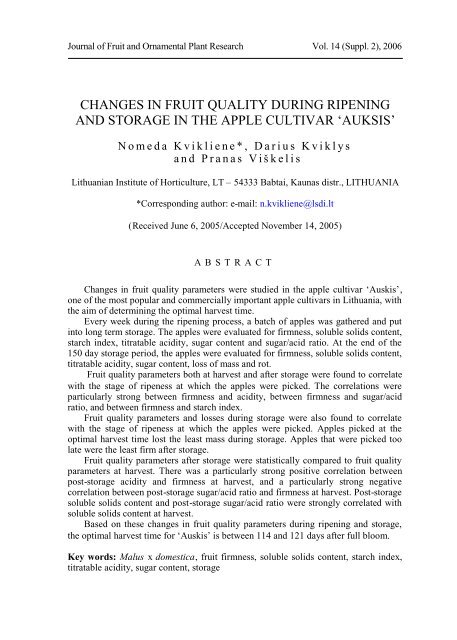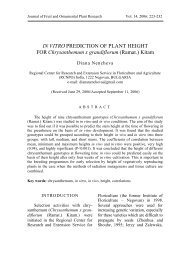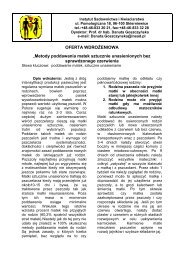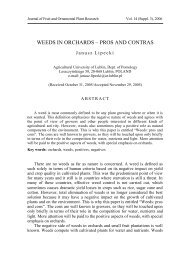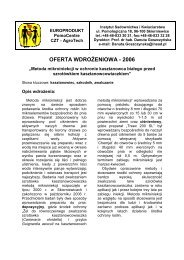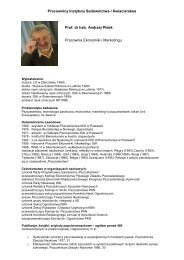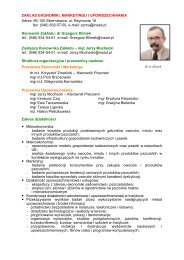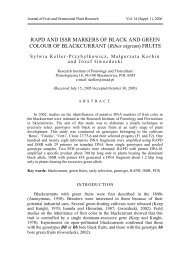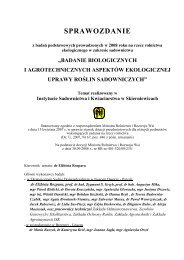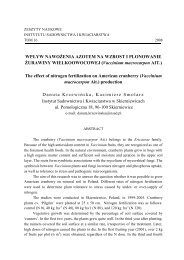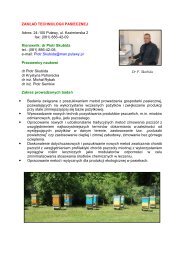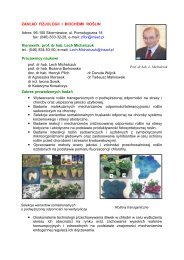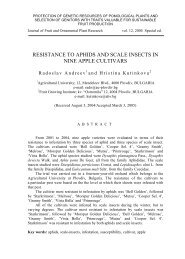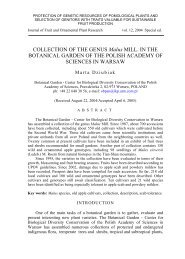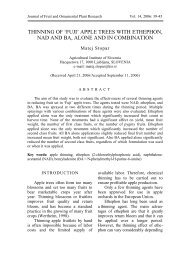changes in fruit quality during ripening and storage in the apple ...
changes in fruit quality during ripening and storage in the apple ...
changes in fruit quality during ripening and storage in the apple ...
You also want an ePaper? Increase the reach of your titles
YUMPU automatically turns print PDFs into web optimized ePapers that Google loves.
Journal of Fruit <strong>and</strong> Ornamental Plant Research Vol. 14 (Suppl. 2), 2006<br />
CHANGES IN FRUIT QUALITY DURING RIPENING<br />
AND STORAGE IN THE APPLE CULTIVAR ‘AUKSIS’<br />
N o m e d a K v i k l i e n e * , D a r i u s K v i k l y s<br />
a n d P r a n a s V i šk e l i s<br />
Lithuanian Institute of Horticulture, LT – 54333 Babtai, Kaunas distr., LITHUANIA<br />
*Correspond<strong>in</strong>g author: e-mail: n.kvikliene@lsdi.lt<br />
(Received June 6, 2005/Accepted November 14, 2005)<br />
A B S T R A C T<br />
Changes <strong>in</strong> <strong>fruit</strong> <strong>quality</strong> parameters were studied <strong>in</strong> <strong>the</strong> <strong>apple</strong> cultivar ‘Auskis’,<br />
one of <strong>the</strong> most popular <strong>and</strong> commercially important <strong>apple</strong> cultivars <strong>in</strong> Lithuania, with<br />
<strong>the</strong> aim of determ<strong>in</strong><strong>in</strong>g <strong>the</strong> optimal harvest time.<br />
Every week dur<strong>in</strong>g <strong>the</strong> ripen<strong>in</strong>g process, a batch of <strong>apple</strong>s was ga<strong>the</strong>red <strong>and</strong> put<br />
<strong>in</strong>to long term <strong>storage</strong>. The <strong>apple</strong>s were evaluated for firmness, soluble solids content,<br />
starch <strong>in</strong>dex, titratable acidity, sugar content <strong>and</strong> sugar/acid ratio. At <strong>the</strong> end of <strong>the</strong><br />
150 day <strong>storage</strong> period, <strong>the</strong> <strong>apple</strong>s were evaluated for firmness, soluble solids content,<br />
titratable acidity, sugar content, loss of mass <strong>and</strong> rot.<br />
Fruit <strong>quality</strong> parameters both at harvest <strong>and</strong> after <strong>storage</strong> were found to correlate<br />
with <strong>the</strong> stage of ripeness at which <strong>the</strong> <strong>apple</strong>s were picked. The correlations were<br />
particularly strong between firmness <strong>and</strong> acidity, between firmness <strong>and</strong> sugar/acid<br />
ratio, <strong>and</strong> between firmness <strong>and</strong> starch <strong>in</strong>dex.<br />
Fruit <strong>quality</strong> parameters <strong>and</strong> losses dur<strong>in</strong>g <strong>storage</strong> were also found to correlate<br />
with <strong>the</strong> stage of ripeness at which <strong>the</strong> <strong>apple</strong>s were picked. Apples picked at <strong>the</strong><br />
optimal harvest time lost <strong>the</strong> least mass dur<strong>in</strong>g <strong>storage</strong>. Apples that were picked too<br />
late were <strong>the</strong> least firm after <strong>storage</strong>.<br />
Fruit <strong>quality</strong> parameters after <strong>storage</strong> were statistically compared to <strong>fruit</strong> <strong>quality</strong><br />
parameters at harvest. There was a particularly strong positive correlation between<br />
post-<strong>storage</strong> acidity <strong>and</strong> firmness at harvest, <strong>and</strong> a particularly strong negative<br />
correlation between post-<strong>storage</strong> sugar/acid ratio <strong>and</strong> firmness at harvest. Post-<strong>storage</strong><br />
soluble solids content <strong>and</strong> post-<strong>storage</strong> sugar/acid ratio were strongly correlated with<br />
soluble solids content at harvest.<br />
Based on <strong>the</strong>se <strong>changes</strong> <strong>in</strong> <strong>fruit</strong> <strong>quality</strong> parameters dur<strong>in</strong>g ripen<strong>in</strong>g <strong>and</strong> <strong>storage</strong>,<br />
<strong>the</strong> optimal harvest time for ‘Auskis’ is between 114 <strong>and</strong> 121 days after full bloom.<br />
Key words: Malus x domestica, <strong>fruit</strong> firmness, soluble solids content, starch <strong>in</strong>dex,<br />
titratable acidity, sugar content, <strong>storage</strong>
N. Kvikliene et al.<br />
INTRODUCTION<br />
‘Auksis’ is one of <strong>the</strong> most popular <strong>and</strong> commercially important <strong>apple</strong><br />
cultivars <strong>in</strong> Lithuania, where it makes up about 15% of <strong>the</strong> national crop. It is<br />
a particularly tasty <strong>and</strong> attractive variety, <strong>and</strong> is also quite w<strong>in</strong>ter hardy.<br />
‘Auksis’ is picked at <strong>the</strong> beg<strong>in</strong>n<strong>in</strong>g of September, <strong>and</strong> can be stored until<br />
February. Unfortunately, ‘Auskis’ is prone to <strong>fruit</strong> drop <strong>and</strong> to soften<strong>in</strong>g<br />
dur<strong>in</strong>g <strong>storage</strong>. Therefore, it is very important to systematically monitor<br />
<strong>changes</strong> <strong>in</strong> <strong>fruit</strong> <strong>quality</strong> to determ<strong>in</strong>e optimal harvest time <strong>and</strong> <strong>storage</strong><br />
conditions.<br />
To ensure maximum storability, <strong>apple</strong>s should be picked when mature, but<br />
not fully ripe. If <strong>apple</strong>s are picked when <strong>the</strong>y are too ripe, physiological<br />
processes are underway which complicate <strong>storage</strong>, even under optimal<br />
conditions (Ingle et al., 2000; Braun et al., 1995). Apples picked at right stage<br />
have <strong>the</strong> organoleptic qualities which enable <strong>the</strong>m to survive more than six<br />
months of <strong>storage</strong>.<br />
Most <strong>fruit</strong> <strong>quality</strong> parameters are useful not only for gaug<strong>in</strong>g <strong>fruit</strong><br />
maturity, but for evaluat<strong>in</strong>g <strong>the</strong> eat<strong>in</strong>g <strong>quality</strong> of <strong>the</strong> <strong>apple</strong> as well (Hoehn et<br />
al., 2003). Fruit firmness is a measure of texture. SSC, acidity <strong>and</strong> sugar<br />
content are associated with taste. Volatile substances contribute to <strong>fruit</strong> aroma.<br />
Many factors affect <strong>fruit</strong> <strong>quality</strong>, <strong>in</strong>clud<strong>in</strong>g genetics, soil properties, <strong>and</strong><br />
wea<strong>the</strong>r conditions.<br />
The aim of this study was to <strong>in</strong>vestigate <strong>changes</strong> <strong>in</strong> <strong>fruit</strong> <strong>quality</strong><br />
parameters dur<strong>in</strong>g ripen<strong>in</strong>g <strong>and</strong> <strong>storage</strong> <strong>in</strong> order to determ<strong>in</strong>e <strong>the</strong> optimum<br />
harvest time for <strong>apple</strong>s of <strong>the</strong> cultivar ‘Auksis’.<br />
MATERIAL AND METHODS<br />
In 1997, 2000 <strong>and</strong> 2001, <strong>changes</strong> <strong>in</strong> <strong>fruit</strong> <strong>quality</strong> parameters were studied<br />
<strong>in</strong> <strong>the</strong> <strong>apple</strong> cultivar ‘Auskis’ grafted on MM106 rootstock. The experiment<br />
was carried out with four replicates of ten trees per plot.<br />
Every week dur<strong>in</strong>g <strong>the</strong> ripen<strong>in</strong>g process, a batch of <strong>apple</strong>s was ga<strong>the</strong>red<br />
<strong>and</strong> put <strong>in</strong>to long term <strong>storage</strong>. Batches were picked 100, 107, 114, 121 <strong>and</strong><br />
128 days after full bloom (DAFB). Ten <strong>apple</strong>s from each batch were<br />
immediately evaluated for firmness, soluble solids content, starch <strong>in</strong>dex,<br />
titratable acidity, sugar content <strong>and</strong> sugar/acid ratio. At <strong>the</strong> end of <strong>the</strong> 150 day<br />
<strong>storage</strong> period, 100 <strong>apple</strong>s from each batch were evaluated for firmness,<br />
soluble solids content, titratable acidity sugar content, loss of mass <strong>and</strong> rot.<br />
Firmness was measured with a penetrometer (FT-327) with 11 mm<br />
diameter probe. Soluble solids content was measured with a refractometer.<br />
The starch <strong>in</strong>dex was determ<strong>in</strong>ed us<strong>in</strong>g a 0.1N iod<strong>in</strong>e <strong>and</strong> potassium iod<strong>in</strong>e<br />
solution. Titratable acidity was measured by titration, <strong>and</strong> recorded as<br />
equivalents of malic acid. Sugar content was measured by Bertr<strong>and</strong>’s method<br />
(Peterburskij, 1963).<br />
Data were statistically elaborated us<strong>in</strong>g ANOVA.<br />
196<br />
J. Fruit Ornam. Plant Res. vol. 14 (Suppl. 2), 2006: 195-202
Changes <strong>in</strong> <strong>fruit</strong> <strong>quality</strong> dur<strong>in</strong>g ripen<strong>in</strong>g <strong>and</strong> <strong>storage</strong>….<br />
RESULTS<br />
From 100 to 128 DAFB, <strong>fruit</strong> firmness decreased by an average of 20%<br />
(Tab. 1). This is confirmed by <strong>the</strong> strong negative correlation between DAFB<br />
<strong>and</strong> firmness (Tab. 3). Dur<strong>in</strong>g <strong>storage</strong>, <strong>fruit</strong> firmness decreased by 41 to 51%<br />
of its orig<strong>in</strong>al value (Tab. 2). Apples which were picked later were less firm<br />
both at harvest time <strong>and</strong> at <strong>the</strong> end of <strong>the</strong> <strong>storage</strong> period, though <strong>the</strong> difference<br />
at <strong>the</strong> end of <strong>the</strong> <strong>storage</strong> period was significant only between <strong>the</strong> first <strong>and</strong> <strong>the</strong><br />
last batches picked. Fruit firmness after <strong>storage</strong> was not highly correlated with<br />
firmness at pick<strong>in</strong>g time (Tab. 4).<br />
T a b l e 1 . Effect of harvest time on <strong>fruit</strong> <strong>quality</strong> dur<strong>in</strong>g ripen<strong>in</strong>g (mean of 1997,<br />
2000 <strong>and</strong> 2001)<br />
Harvest<br />
time <strong>in</strong><br />
days after<br />
full bloom<br />
(DAFB)<br />
Firmness<br />
[kg]<br />
Soluble<br />
solids<br />
content<br />
[%]<br />
Starch<br />
<strong>in</strong>dex<br />
Titratable<br />
acidity<br />
[%]<br />
Sugar<br />
content<br />
[%]<br />
Sugar/acid<br />
ratio<br />
100 10.2 11.2 2.1 0.73 8.64 12.31<br />
107 9.2 11.4 3.0 0.76 9.98 12.36<br />
114 8.6 12.3 4.1 0.62 8.96 16.23<br />
121 8.2 12.4 5.0 0.57 10.05 18.80<br />
128 8.2 12.3 6.5 0.55 10.65 19.54<br />
LSD 05 0.35 0.29 0.64 0.082 1.175 2.986<br />
T a b l e 2 . Effect of harvest time on <strong>fruit</strong> <strong>quality</strong> after <strong>the</strong> <strong>storage</strong> (mean of 1997,<br />
2000, 2001)<br />
Harvest time<br />
<strong>in</strong> days after<br />
full bloom<br />
(DAFB)<br />
Firmness<br />
[kg]<br />
Soluble<br />
solids<br />
content<br />
[%]<br />
Titratable<br />
acidity<br />
[%]<br />
Sugar<br />
content<br />
[%]<br />
Mass<br />
loss<br />
[%]<br />
Loss<br />
due to<br />
rot<br />
[%]<br />
100 5.0 12.1 0.37 9.5 4.6 4.8<br />
107 5.0 12.3 0.33 9.9 3.7 5.9<br />
114 5.1 12.8 0.30 9.6 3.5 6.0<br />
121 4.8 12.5 0.30 10.2 3.4 6.9<br />
128 4.7 12.6 0.29 10.05 4.5 10.8<br />
LSD 05 0.28 0.19 0.058 0.49 0.48 2.52<br />
Soluble solids content (SSC) abruptly <strong>in</strong>creased between 107 <strong>and</strong> 114<br />
DAFB, after which it levelled off (Tab. 1). There was no apparent correlation<br />
between SSC <strong>and</strong> DAFB (Tab. 3). Apples picked 114 DAFB had <strong>the</strong> highest<br />
post <strong>storage</strong> SSC, whereas <strong>apple</strong>s picked 100 DAFB had <strong>the</strong> lowest post<strong>storage</strong><br />
SSC (Tab. 2). There was a positive correlation between SSC after<br />
<strong>storage</strong> <strong>and</strong> SSC at harvest time (Tab. 4).<br />
J. Fruit Ornam. Plant Res. vol. 14 (Suppl. 2), 2006:195-202 197
N. Kvikliene et al.<br />
T a b l e 3 . Correlations among <strong>fruit</strong> <strong>quality</strong> parameters at harvest (mean of 1997,<br />
2000 <strong>and</strong> 2001)<br />
Firmness SSC<br />
Starch<br />
Sugar Sugar/acid<br />
TA<br />
<strong>in</strong>dex<br />
content ratio<br />
DAFB -0.92** 0.49* 0.98** -0.81** 0.78** 0.96**<br />
Firmness -0.79** -0.91** 0.83** 0.40* 0.85**<br />
SSC 0.77** 0.67** 0.30 0.74**<br />
Starch <strong>in</strong>dex -0.84** 0.55** 0.86**<br />
TA -0.36 -0.95**<br />
Sugar content 0.48*<br />
*Significant at P≤0.05<br />
**Significant at P≤0.01<br />
T a b l e 4 . Correlations among <strong>fruit</strong> <strong>quality</strong> parameters at harvest after 150 days of<br />
<strong>storage</strong> (mean of 1997, 2000 <strong>and</strong> 2001)<br />
At harvest<br />
firmness SSC TA<br />
After <strong>storage</strong><br />
sugar<br />
content<br />
sugar/<br />
acid<br />
mass<br />
loss<br />
loss<br />
due to<br />
rot<br />
DAFB -0.64** 0.56** -0.68** 0.50* 0.72** 0.61** 0.51**<br />
Firmness 0.54** -0.50* 0.75** -0.38 -0.77** -0.47* 0.44*<br />
SSC -0.42* 0.72** -0.68** 0.51** 0.71** 0.49* 0.39<br />
Starch<br />
<strong>in</strong>dex<br />
-0.65** 0.52** -0.67** 0.41* 0.70** 0.64** 0.55**<br />
TA 0.44* -0.42* 0.59** 0.28 0.63** -0.36 -0.30<br />
Sugar<br />
content<br />
-0.51** 0.44* -0.30 0.59** 0.43* 0.50* 0.37<br />
Sugar/acid<br />
ratio<br />
-0.46* 0.56** -0.67** 0.41* 0.71** 0.44* 0.35<br />
*Significant at P≤0.05<br />
**Significant at P≤0.01<br />
Starch <strong>in</strong>dex decl<strong>in</strong>ed dur<strong>in</strong>g <strong>the</strong> maturation period. The starch conversion<br />
rate did not differ significantly from year to year of <strong>the</strong> study. There was<br />
a very strong positive correlation between starch <strong>in</strong>dex <strong>and</strong> DAFB, <strong>and</strong><br />
a negative correlation between starch <strong>in</strong>dex <strong>and</strong> firmness.<br />
Dur<strong>in</strong>g <strong>the</strong> maturation period, sugar content <strong>in</strong>creased by 23% <strong>and</strong><br />
titratable acidity decreased by 30% (Tab. 1). As expected, sugar content <strong>and</strong><br />
acidity were strongly correlated with DAFB (Tab. 3). After <strong>storage</strong>, acidity<br />
decreased by 47 to 67% of its harvest value. Post-<strong>storage</strong> acidity was<br />
negatively correlated with DAFB (Tab. 2). Apples picked 107 <strong>and</strong> 114 DAFB<br />
had <strong>the</strong> highest relative drop <strong>in</strong> acidity by <strong>the</strong> end of <strong>the</strong> <strong>storage</strong> period, los<strong>in</strong>g<br />
52 to 57% of <strong>the</strong> value at harvest. Apples picked 128 DAFB had <strong>the</strong> lowest<br />
relative drop <strong>in</strong> acidity. The correlations between DAFB <strong>and</strong> acidity <strong>and</strong><br />
between DAFB <strong>and</strong> sugar content were not as strong after <strong>storage</strong> as <strong>the</strong>y<br />
were at harvest time.<br />
198<br />
J. Fruit Ornam. Plant Res. vol. 14 (Suppl. 2), 2006: 195-202
Changes <strong>in</strong> <strong>fruit</strong> <strong>quality</strong> dur<strong>in</strong>g ripen<strong>in</strong>g <strong>and</strong> <strong>storage</strong>….<br />
Dur<strong>in</strong>g <strong>the</strong> maturation period, <strong>the</strong> sugar/acid ration <strong>in</strong>creased from 12.3 to<br />
19.5. There was a very strong correlation between <strong>the</strong> sugar/acid ratio <strong>and</strong><br />
DAFB. There were also significant correlations between <strong>the</strong> sugar/acid ratio<br />
<strong>and</strong> all of <strong>the</strong> o<strong>the</strong>r <strong>fruit</strong> <strong>quality</strong> parameters, both at harvest time <strong>and</strong> after<br />
<strong>storage</strong>.<br />
Dur<strong>in</strong>g <strong>the</strong> 150 day <strong>storage</strong> period, <strong>the</strong> <strong>apple</strong>s lost 3.4 to 4.6% of <strong>the</strong>ir<br />
mass due to water loss. Apples picked 100 <strong>and</strong> 128 DAFB lost <strong>the</strong> most of<br />
mass, whereas <strong>apple</strong>s picked 114 <strong>and</strong> 121 DAFB lost <strong>the</strong> least. Mass loss was<br />
most strongly correlated with starch <strong>in</strong>dex at harvest, <strong>and</strong> less so with <strong>the</strong><br />
o<strong>the</strong>r <strong>fruit</strong> <strong>quality</strong> parameters.<br />
The <strong>in</strong>cidence of rot was 4.8 to 10.8%, <strong>and</strong> was positively correlated with<br />
DAFB. Loss due to rot was 4.8% <strong>in</strong> <strong>apple</strong>s picked 100 DAFB, <strong>and</strong> 10.8% <strong>in</strong><br />
<strong>apple</strong>s picked 128 DAFB.<br />
DISCUSSION<br />
Fruit <strong>quality</strong> varies from year to year, <strong>and</strong> depends largely on grow<strong>in</strong>g<br />
conditions dur<strong>in</strong>g <strong>the</strong> vegetative season. None<strong>the</strong>less, <strong>the</strong> <strong>changes</strong> <strong>in</strong> <strong>fruit</strong><br />
<strong>quality</strong> parameters that occur dur<strong>in</strong>g <strong>the</strong> ripen<strong>in</strong>g period follow <strong>the</strong> same<br />
pattern every year. The <strong>changes</strong> observed <strong>in</strong> this study were generally those<br />
expected <strong>and</strong> agreed well with previous studies which also used <strong>the</strong> date of<br />
full bloom as a reference po<strong>in</strong>t (Braun et al., 1995; Zude-Sasse et al., 2001;<br />
Ingle et al., 2000; Eccher Zerb<strong>in</strong>i et al., 1999; Kvikliene, 2004). Fruits that<br />
were harvested later were softer <strong>and</strong> less tart, <strong>and</strong> had a higher starch <strong>in</strong>dex<br />
<strong>and</strong> SSC.<br />
The rate of <strong>fruit</strong> soften<strong>in</strong>g was <strong>the</strong> same <strong>in</strong> all years of <strong>the</strong> study, <strong>and</strong><br />
depended only on DAFB. Apples which were harvested <strong>the</strong> earliest were<br />
firmest both before <strong>and</strong> after <strong>storage</strong>, but lost a greater percentage of <strong>the</strong>ir<br />
firmness dur<strong>in</strong>g <strong>storage</strong>. Apples harvested 100 DAFB had a firmness of 10.2<br />
kg at harvest <strong>and</strong> 5.0 kg after <strong>storage</strong>, <strong>and</strong> lost 51% of <strong>the</strong>ir <strong>in</strong>itial firmness.<br />
Apples harvested 128 DAFB had a firmness of 8.2 kg at harvest <strong>and</strong> 4.7 kg<br />
after <strong>storage</strong>, <strong>and</strong> lost 43% of <strong>the</strong>ir <strong>in</strong>itial firmness. Apples harvested 114 <strong>and</strong><br />
121 DAFB lost only 41% of <strong>the</strong>ir <strong>in</strong>itial firmness. This agrees well with an<br />
earlier study on <strong>fruit</strong> soften<strong>in</strong>g <strong>in</strong> o<strong>the</strong>r cultivars (Meresz et al., 1993).<br />
However, <strong>the</strong> soften<strong>in</strong>g rate has also been reported to vary from cultivar to<br />
cultivar, depend<strong>in</strong>g on <strong>the</strong> presence <strong>and</strong> expression of genes which regulate<br />
<strong>the</strong> activity of hydrolytic enzymes (Ingle et al., 2000; Konopacka <strong>and</strong><br />
Plocharski, 2002; Johnston et al., 2001).<br />
SSC varied from year to year <strong>and</strong> was dependent more on wea<strong>the</strong>r<br />
conditions than on any o<strong>the</strong>r factor. Apples which are harvested later have<br />
been reported to have a higher SSC both at harvest <strong>and</strong>, generally, after<br />
<strong>storage</strong> as well (Ingle et al., 2000). In our study, <strong>the</strong> <strong>apple</strong>s with <strong>the</strong> highest<br />
post-<strong>storage</strong> SSC were those harvested 114 DAFB. However, <strong>in</strong> o<strong>the</strong>r<br />
cultivars, post-<strong>storage</strong> SSC was not significantly affected by harvest time<br />
(Kvikliene, 2004; Braun et al., 1995).<br />
J. Fruit Ornam. Plant Res. vol. 14 (Suppl. 2), 2006:195-202 199
N. Kvikliene et al.<br />
Changes <strong>in</strong> sugar content dur<strong>in</strong>g <strong>storage</strong> were generally more subtle <strong>and</strong> it<br />
is difficult to dist<strong>in</strong>guish any clear patterns. Post-<strong>storage</strong> sugar content was<br />
most strongly correlated with sugar content at harvest, SSC <strong>and</strong> DAFB, <strong>and</strong><br />
less so with <strong>the</strong> o<strong>the</strong>r <strong>fruit</strong> <strong>quality</strong> parameters.<br />
Post-<strong>storage</strong> titratable acidity <strong>and</strong> sugar/acid ratio, on <strong>the</strong> o<strong>the</strong>r h<strong>and</strong>, were<br />
strongly correlated with all of <strong>the</strong> <strong>fruit</strong> <strong>quality</strong> parameters at harvest time<br />
except for sugar content.<br />
Loss of mass <strong>and</strong> decay dur<strong>in</strong>g <strong>storage</strong> can greatly affect marketability.<br />
Mass loss dur<strong>in</strong>g <strong>storage</strong> depends on <strong>fruit</strong> maturity at harvest time (Ferguson<br />
et al., 1999). Apples picked too early or too late lost more mass than <strong>apple</strong>s<br />
picked at <strong>the</strong> optimum stage of ripeness. Apples which are picked earlier are<br />
less prone to rot, but are not as tasty <strong>and</strong> attractive than <strong>apple</strong>s which are<br />
picked later. Apples picked 128 DAFB were over-ripe <strong>and</strong> too metabolically<br />
active, whereas <strong>apple</strong>s picked 114 <strong>and</strong> 121 DAFB lost <strong>the</strong> least mass. Fruit<br />
picked at <strong>the</strong> optimal harvest time lose less mass dur<strong>in</strong>g <strong>storage</strong> than <strong>fruit</strong>s<br />
picked too early or too late (Elgar et. al., 1999; DeLong et al., 1999; Dris <strong>and</strong><br />
Niskanen 1999).<br />
Based on <strong>the</strong> <strong>changes</strong> <strong>in</strong> <strong>fruit</strong> <strong>quality</strong> parameters dur<strong>in</strong>g ripen<strong>in</strong>g <strong>and</strong><br />
<strong>storage</strong>, <strong>the</strong> optimal harvest time for ‘Auskis’ is between 114 <strong>and</strong> 121 days<br />
after full bloom.<br />
REFERENCES<br />
Braun H., Brosh B., Ecker P., Krumbock K. 1995. Changes <strong>in</strong> <strong>quality</strong> off <strong>apple</strong>s<br />
before, dur<strong>in</strong>g <strong>and</strong> after CA-cold <strong>storage</strong>. OBSTAU UND FRUCHTE-<br />
VERWERTUNG 45(5-6): 143-206.<br />
DeLong J.M., Prange R.K., Harison P.A., Shofield R.A. <strong>and</strong> DeEll J.R.1999. Us<strong>in</strong>g<br />
<strong>the</strong> Streif <strong>in</strong>dex as a f<strong>in</strong>al harvest w<strong>in</strong>dow for controlled-atmosphere <strong>storage</strong><br />
<strong>apple</strong>s. HORTSCIENCE 34(7): 1251-1255.<br />
Dris R., Niskanen R.1999. Quality <strong>changes</strong> of ‘Lobo’ <strong>apple</strong>s dur<strong>in</strong>g cold <strong>storage</strong>.<br />
ACTA HORT. 485: 125-133.<br />
Eccher Zerb<strong>in</strong>i P., Pianezzola A., Grassi M. 1999. Post<strong>storage</strong> sensory profiles of <strong>fruit</strong> of<br />
<strong>apple</strong> cultivars harvested at different maturity stages. J. FOOD QUAL. 22(1): 1-17.<br />
Elgar H. J., Watk<strong>in</strong>s C.B., Lalu N. 1999. Harvest date <strong>and</strong> crop load effects on<br />
a carbon dioxide-related <strong>storage</strong> <strong>in</strong>jury of ‘Braeburn’ <strong>apple</strong>. HORTSCIENCE<br />
34(2): 305-309.<br />
Ferguson I., Volz R., Woolf A. 1999. Preharvest factors affect<strong>in</strong>g physiological<br />
disorders of <strong>fruit</strong>. POSTHAR. BIOL TECHNOL. 15: 255-262.<br />
Hoehn E., Gasser F., Guggenbuhl B., Kunsch U. 2003. Efficacy of <strong>in</strong>strumental<br />
measurements for determ<strong>in</strong>ation of m<strong>in</strong>imum requirements of firmness, soluble<br />
solids, <strong>and</strong> acidity of several <strong>apple</strong> varieties <strong>in</strong> comparison to consumer<br />
expectations. POSTHAR. BIOL. TECHNOL. 27: 27-37.<br />
Ingle M., D’Souza M.C., Townsend E.C. 2000. Fruit characteristics of York <strong>apple</strong>s<br />
dur<strong>in</strong>g development <strong>and</strong> after <strong>storage</strong>. HORT SCIENCE. 35(1): 95-98.<br />
Johnston D.S., Hewett E.W., Banks N.H., Harker F.R., Hertog M.L.A.T.M. 2001.<br />
Physical change <strong>in</strong> <strong>apple</strong> texture with <strong>fruit</strong> temperature: Effect of cultivar <strong>and</strong><br />
time of <strong>storage</strong>. POSTHAR. BIOL. TECHNOL. 16: 107-118.<br />
200<br />
J. Fruit Ornam. Plant Res. vol. 14 (Suppl. 2), 2006: 195-202
Changes <strong>in</strong> <strong>fruit</strong> <strong>quality</strong> dur<strong>in</strong>g ripen<strong>in</strong>g <strong>and</strong> <strong>storage</strong>….<br />
Konopacka D., Płocharski W.J. 2002. Effect of pick<strong>in</strong>g maturity, <strong>storage</strong> technology<br />
<strong>and</strong> shelf-life on <strong>changes</strong> of <strong>apple</strong> firmness of ‘Elstar’, ‘Jonagold’ <strong>and</strong> ‘Gloster’<br />
cultivars. J. FRUIT ORNAM. PLANT RES. 10: 11-22.<br />
Kvikliene N. 2004. Influence of harvest date on physiological <strong>and</strong> biochemical<br />
processes <strong>in</strong> <strong>apple</strong> <strong>fruit</strong>. HORTICULTURE AND VEGETABLE GROWING.<br />
23(2): 412-420<br />
Meresz P., El Abbasi O.K., Sass P. 1993. Quality <strong>changes</strong> of <strong>apple</strong>s dur<strong>in</strong>g <strong>storage</strong>.<br />
ACTA AGRONOM. HUNG. 42 (3-4): 293-301.<br />
Peterburskij A.V. 1963. Praktikum po agronomicheskoj khimii. Moskva, 592 (<strong>in</strong><br />
Russian).<br />
Zude-Sasse m., Herold B., Geyer M., Huyskens-Keil S. 2001. Influence of maturity<br />
stage on physical properties <strong>in</strong> <strong>apple</strong>. ACTA HORT. 553(1): 109-110.<br />
ZMIANY JAKOŚCI JABŁEK ODMIANY ‘AUKSIS’<br />
PODCZAS DOJRZEWANIA I PRZECHOWYWANIA<br />
N o m e d a K v i k l i e n e , D a r i u s K v i k l y s<br />
i P r a n a s V i šk e l i s<br />
S T R E S Z C Z E N I E<br />
Badania jakości owoców przeprowadzono na jabłkach odmiany ‘Auksis’<br />
zebranych pomiędzy 100-128 dniem po pełni kwitnienia (DAFB). Ich celem było<br />
określenie optymalnego term<strong>in</strong>u zbioru. Partie owoców przeznaczone do długiego<br />
przechowywania zbierano co tydzień. W każdym term<strong>in</strong>ie zbioru jabłek oznaczano<br />
jędrność, zawartość ekstraktu (SSC), kwasowość miareczkową (TA), <strong>in</strong>deks<br />
skrobiowy (SI), zawartośćcukrów i stosunek cukrów do kwasów. Po zakończeniu<br />
przechowywania, po 150 dniach, określono jędrność, zawartośćekstraktu, kwasowość<br />
miareczkową, zawartośćcukrów, ubytki masy i obecnośćchorób przechowalniczych.<br />
Parametry jakości owoców oznaczane zarówno podczas zbioru, jak i po<br />
przechowywaniu były skorelowane ze stadium dojrzałości w jakim znajdowały się<br />
owoce w momencie zbioru. Szczególnie silne korelacje występowały pomiędzy<br />
jędrnościąi kwasowością, jędrnościąi stosunkiem cukrów do kwasów oraz jędrnością<br />
i <strong>in</strong>deksem skrobiowym.<br />
Parametry jakości owoców i ubytki podczas przechowywania równieżkorelowały<br />
ze stadium dojrzałości w jakim jabłka były zebrane. Owoce zebrane w optymalnym<br />
term<strong>in</strong>ie miały najmniejsze ubytki masy po przechowywaniu. Owoce zebrane zbyt<br />
późno były po przechowywaniu najmniej jędrne.<br />
Porównano parametry jakości owoców oznaczone na zbiorze i po zakończeniu<br />
przechowywania. Jędrnośćowoców na zbiorze silnie pozytywnie korelowała z TA<br />
i negatywnie ze stosunkiem cukrów do kwasów po przechowywaniu. SSC oznaczona<br />
J. Fruit Ornam. Plant Res. vol. 14 (Suppl. 2), 2006:195-202 201
N. Kvikliene et al.<br />
podczas zbiorów korelowała dodatnio z SSC i stosunkiem cukrów do kwasów po<br />
przechowywaniu.<br />
Na podstawie zmian parametrów jakości owoców podczas dojrzewania<br />
i w trakcie przechowywania, za optymalny term<strong>in</strong> zbioru jabłek odmiany ‘Auksis’<br />
można uznaćczas pomiędzy 114 a 121 dniem po pełni kwitnienia.<br />
Słowa kluczowe: Malus x domestica, jędrnośćowoców, zawartośćekstraktu, <strong>in</strong>deks<br />
skrobiowy, kwasowośćmiareczkowa, zawartośćcukrów, przechowywanie<br />
202<br />
J. Fruit Ornam. Plant Res. vol. 14 (Suppl. 2), 2006: 195-202


